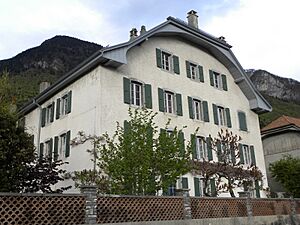Yvorne facts for kids
Quick facts for kids
Yvorne
|
||
|---|---|---|

Yvorne village
|
||
|
||
| Country | Switzerland | |
| Canton | Vaud | |
| District | Aigle | |
| Area | ||
| • Total | 12.2 km2 (4.7 sq mi) | |
| Elevation | 454 m (1,490 ft) | |
| Population
(Dec 2020 )
|
||
| • Total | 1,070 | |
| • Density | 87.7/km2 (227.2/sq mi) | |
| Postal code |
1853
|
|
| Surrounded by | Aigle, Chessel, Corbeyrier, Leysin, Roche, Vouvry (VS) | |
Yvorne is a charming municipality located in the canton of Vaud, Switzerland. It is part of the Aigle district. This lovely Swiss town is known for its beautiful landscapes and delicious white wine.
Contents
Geography and Nature
Yvorne covers an area of about 12.2 square kilometers (4.7 square miles). A large part of this land, nearly half, is used for farming. Forests cover almost 40% of the area, making it a very green place.
About 10% of Yvorne is covered by buildings and roads. The rest of the land includes rivers, lakes, and some areas that are not used for farming or building. Yvorne is especially famous for its vineyards, which produce a well-known white wine.
Town Symbol: Coat of Arms
The official symbol of Yvorne is its coat of arms. It shows two main parts. The top part is gold with a black letter "Y". The bottom part is black with a golden bunch of grapes. This design highlights the town's name and its important wine-growing tradition.
People and Population
Yvorne has a population of around 1,000 people. A small part of the population, about 12%, are people from other countries. Over the past ten years, the number of people living in Yvorne has stayed quite steady.
Most people in Yvorne speak French, which is the main language. A smaller number of people speak German or Italian. Many residents were born in Yvorne or in the same canton, Vaud. Others come from different parts of Switzerland or from outside the country.
The population of Yvorne includes people of all ages. About 10% are young children, and another 10% are teenagers. Adults make up the largest part of the population, with a good number of senior citizens as well.
Most households in Yvorne are made up of families or single people. The town has a mix of single-family homes and multi-family buildings. Many of these buildings have been around for a long time, showing the town's history.
The number of people living in Yvorne has changed over the years. You can see how the population has grown and shrunk in the chart below:

Economy and Jobs
Yvorne has a low unemployment rate, meaning most people who want to work can find a job. The town's economy is divided into three main parts:
- Primary Sector: This includes jobs related to farming and agriculture. Many people in Yvorne work in this area, especially in the vineyards.
- Secondary Sector: This involves manufacturing and construction. There are some businesses in Yvorne that make goods or build things.
- Tertiary Sector: This is the largest sector and includes jobs in services. Many people work in sales, hotels, restaurants, transportation, and healthcare.
Many people who live in Yvorne travel to other towns for work. However, some people also come into Yvorne for their jobs. Most people use private cars to get to work, but some also use public transportation.
Religion in Yvorne
In Yvorne, the main religions are Roman Catholic and Swiss Reformed Church. A majority of the population belongs to the Swiss Reformed Church. There are also smaller groups of other Christian faiths and Islamic people. Some residents do not belong to any church.
Education and Schools
Education is important in Yvorne. Many adults have completed high school, and a good number have gone on to college or university.
The local school system provides education for children from pre-school through lower secondary school. Pre-school is not required but is available. Primary school lasts for four years, and lower secondary school lasts for six years. In recent years, there have been around 80-90 students in the Yvorne school district. Some students also attend schools outside the municipality.
See also
 In Spanish: Yvorne para niños
In Spanish: Yvorne para niños






